
Top 10 Plants For The Office
Table of Contents
“Never go to a doctor whose office plants have died.” – Erma Bombeck
Are you looking for the best plants for your office? Then you have come to the right place! Our top 10 picks are what you need to get started.
Office plants serve a variety of purposes.
They add to the aesthetics of an office and help create a welcoming atmosphere.
An office plant has a variety of health benefits, can reduce noise levels, release oxygen, and scrub toxins from the air.
A note for home offices though. If you have pets, make sure that the plants that you purchase are safe for your cats, dogs or other pets!
According to NASA, indoor plant sales are also booming as a result of urbanization, new interior design trends, and millennials’ desire to have something to nurture and care for.
There are also some very unique and interesting ways to display these plants and you can check them and find even more sustainable ideas on growerology.com.
We will look at the best top 10 plants that will add benefits to your office environment and viable options for those of us with allergies.
Our List of Best 10 Office Plants
1. SPIDER PLANT
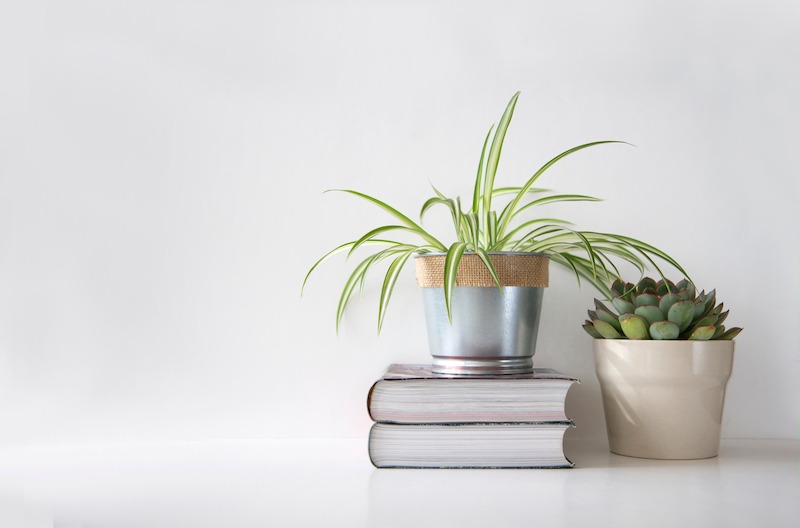
What is this plant’s benefit for my office? It increases indoor oxygen levels.
Characteristics: A spider plant is one of the most convenient plants to grow indoors. It has long, thin, arched foliage that is solid green or variegated with white.
Light: Keep plants in bright to moderate indirect sunlight. Spider plants do not like direct, hot sunlight.
Soil: Plan to repot a spider plant about every other year; otherwise, they may become pot-bound.
Temperature: Spider plants prefer temperatures from 55 to 80 degrees Fahrenheit.
Water: These plants don’t like to be too dry or too wet, so water moderately.
2. SNAKE PLANT

What is this plant’s benefit for my office? It is oxygen-producing, absorbs CO2 at night. This plant is good at absorbing toxins from the air.
Characteristics: It grows long, tall sword-like green leaves and requires little maintenance. This plant can grow to be somewhat tall.
Light: They prefer indirect but steady light with some direct sun. But they can also adapt to full sun conditions and will even survive quite dim areas.
Soil: This plant prefers a loose, well-drained potting mix. An all-purpose cactus potting soil would be ideal.
Temperature: Try and keep the temperature between 70 and 90 degrees Fahrenheit. Take care not to let the temperature fall to or below 50 degrees in the area the plant is located.
Water: Let the soil dry between waterings. With a snake plant, it is better to err on the side of under watering as too much water can kill the plant.
3. POTHOS
(Also known as Devil’s Ivy) (Who comes up with these names?)
What is this plant’s benefit for my office? It’s an air purifier. A pothos is a great way to get started with a foliage friend.
Characteristics: This greenery is very forgiving. With a little care, these plants can last for decades.
Light: They do well in bright, indirect light just as well as in dim light.
Soil: They are not fussy about the type of soil, just make sure it is self-draining so that the roots are not standing directly in water.
Temperature: Pothos plants do best in temperatures of 60 – 80 degrees Fahrenheit, and shouldn’t be grown in less than 40-degree temperatures.
Water: Keep the soil slightly damp but not soaking.
4. PHILODENDRONS

What is this plant’s benefit for my office? It removes formaldehyde from the air. Even someone with little or no experience growing indoor plants will do well with a philodendron.
Characteristics: You can train this viney plant to climb or simply leave it to its own devices, as they are great climbers.
Light: Set this plant in bright but indirect sunlight. Make sure it is not directly in the sun.
Soil: They thrive in soils that are high in organic matter.
Temperature: They can take a wide range of temperature, but prefer to be above 55 degrees Fahrenheit at all times.
Water: Allow the first top inch of soil to dry out before watering.
5. RUBBER PLANTS

What is this plant’s benefit for my office? It cleans the air.
Characteristics: This plant can grow very tall in a relatively short length of time. You can, however, control height by pruning the plant. Plants have green foliage or come in varied greens and splashes of yellow.
Light: They like good light. Avoid direct sunlight and very shady areas.
Soil: Use a well-drained houseplant mix, such as a mixture of three parts loam soil, one part peat, and one part coarse sand is ideal.
Temperature: Normal indoor room temperatures, between 55 and 85 degrees Fahrenheit.
Water: Water them moderately once a week in summer and once every two weeks in winter.
6. CACTUS
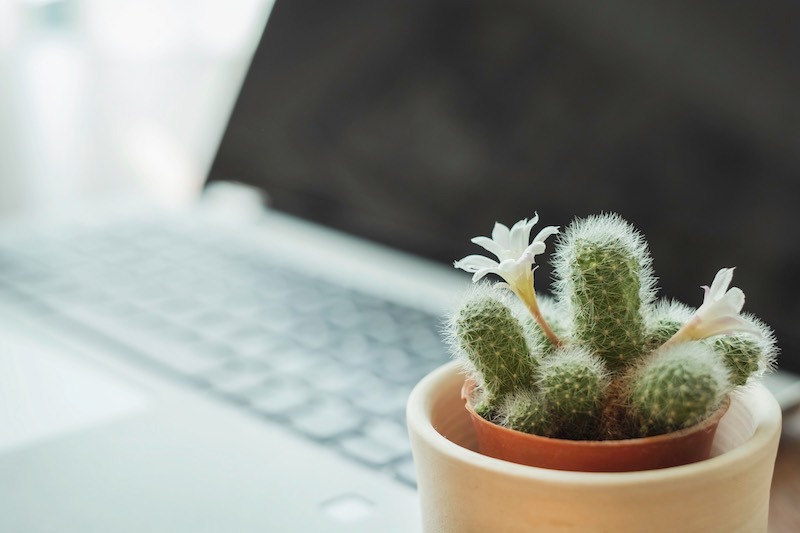
What is this plant’s benefit for my office? It is an air purifier.
Characteristics: Cacti come in a variety of styles, colors, sizes, and shapes. They are unique plants that don’t require much upkeep. Angel Wings, Rat Tail, African Milk Tree, and Saguaro cacti do well in an office setting.
Light: The sun is necessary, but it can get by on just 4 hours a day.
Soil: Soil with good drainage is key to keeping this plant happy.
Temperature: They prefer dry air and average room temperatures.
Water: Moisten the soil, but don’t soak it.
7. ARECA PALMS

What is this plant’s benefit for my office? It purifies the air and adds humidity.
Characteristics: This palm is medium-sized and exotic looking. In an office, it can reach a height of 6 to 8 feet. Make sure to purchase a female plant, as the male contains pollen.
Light: Bright, but indirect, light is best for these palms.
Soil: Use a fertile, acidic soil that drains well.
Temperature: Prefer temperatures between 65 and 75 degrees Fahrenheit. At night, it can go as low as 55 degrees F but is very sensitive to low temperatures.
Water: When watering, keep the soil moist but never soggy.
8. TILLANDSIA
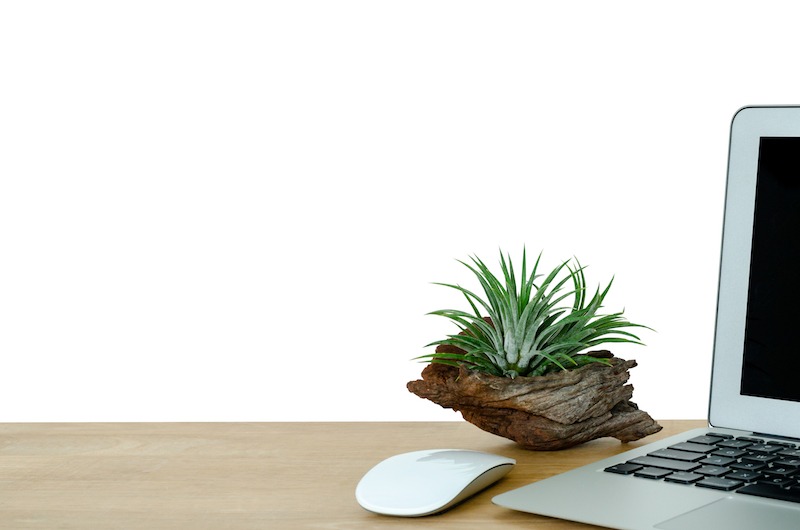
What is this plant’s benefit for my office? It absorbs carbon dioxide.
Characteristics: There are over 650 types of air plants that can thrive and grow without soil. They come in all sizes and colors.
Most air plants grow with strap-shaped or slender triangle-shaped leaves, and most have attractive tubular or funnel-shaped flowers.
Light: They need protection from the full sun. The key to air plant survival is air circulation.
Soil: Although this plant doesn’t need soil, it does need warm temperatures.
Temperature: Anything below 45 degrees Fahrenheit will kill it.
Water: Water once a week. To water, place them in the sink and lightly rinse.
9. DRACAENA
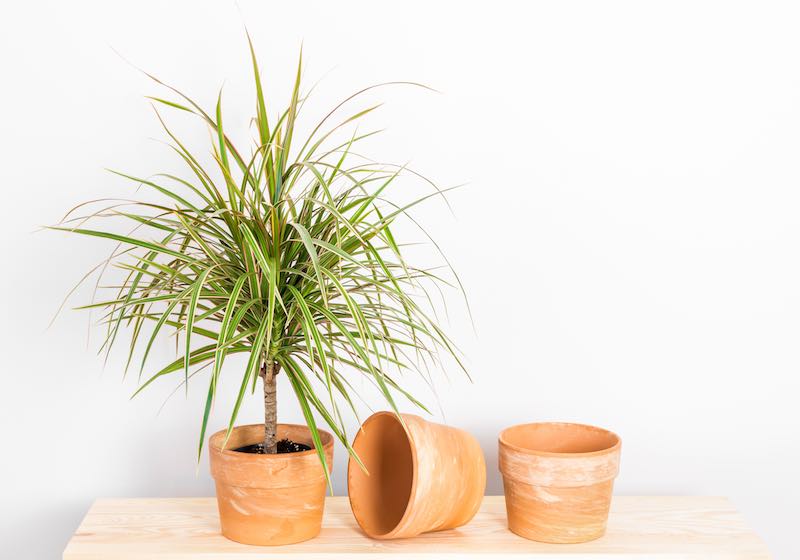
What is this plant’s benefit for my office? It removes benzene, formaldehyde, xylene, and trichloroethylene.
Characteristics: A corn plant is an unbranched, tree-like plant. It has dark-green, sword-like leaves that are about two feet long. The corn plant has a broad cream-to-yellow stripe down the middle. Can get to be six feet tall.
Light: It likes bright light but will tolerate low light. Do not keep in hot, direct sunlight.
Soil: Good-quality, all-purpose potting mix.
Temperature: Average temperatures between 65 and 75 degrees Fahrenheit. Do not allow the temperature to fall below 55 degrees Fahrenheit.
Water: Keep the soil moist, but not soggy.
10. SUCCULENTS
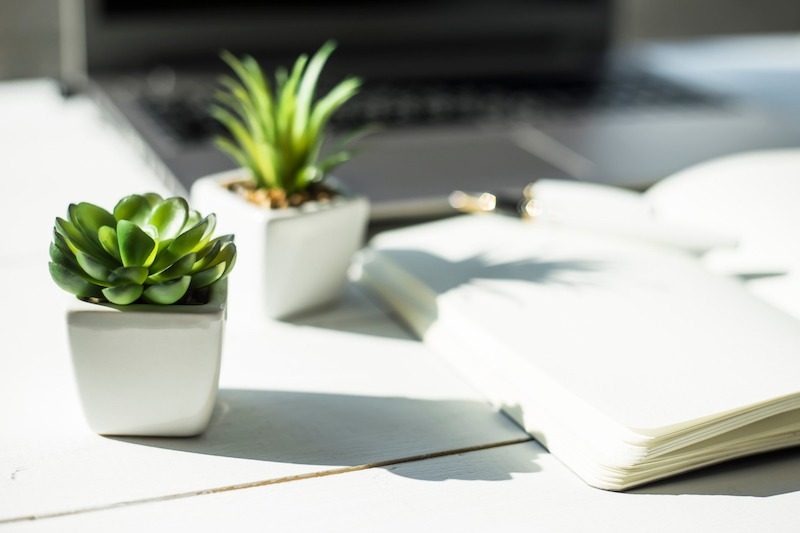
What is this plant’s benefit for my office? It cleans the air.
Characteristics: There are about 300 different kinds of succulents. Some of those that would thrive in an office setting include Aloe vera, Jade, Agave, and Zebra. They look especially nice in a terrarium. Are available in sizes from 3 inches to 10 feet. They are an ‘art form’ because of their unique shapes.
Light: Thrive in almost any light condition
Water: Can survive up to 4 weeks or more without watering
We had spoken earlier about those of us with allergies. All of the plants on our top 10 best list should not trigger any allergic reactions. It is good to be aware of what could trigger allergies.
Why have office plants?
Today’s social media personalities and Instagram influencers have an impact on the plant’s popularity as well.
Experts agree that the trend among the younger set for indoor foliage speaks to this impact.
Studies have also shown that those people who have plants tend to care more about others.
It is not insignificant that tending to nature can make us better human beings! You can check how by reading more articles on ourbeautifulplanet.org
In a previous article, we went in-depth about the benefits of plants in office spaces, and maybe you are interested in obtaining one.
But what type of plant should you choose? What is the best plant for your office?
Not all plants will love to live in your workplace – you need to consider restrictions such as the availability of daylight, and how often they can and will be watered.
The best office plants to choose are easy to care for (and can handle occasional neglect), require limited sunlight, and can thrive in a small amount of space.
There is also more good news about adding plants to your space; there are devices that help us with watering, and so make the job even more comfortable, check youhadmeatgardening.com for some self-watering planters.
You can check even more of the benefits of having office plans in this article.
What plant not to get if you have allergies?
A source of allergens from indoor plants can come from mold. Do not keep the plant’s soil too moist as mold can grow in the soil and the pot.
This can be controlled by being aware of how often you are watering and making sure there is no standing water in the pot.
The soil moisture content can be verified visually or with your hand. Ideally, the topsoil will be drier, but the soil should be moist 1 inch deep.
With indoor plants, best avoid flowers and go for leaves. This limits the amount of pollen in the air, as they are a source of irritants.
If you have allergies, here are some plants you should stay away from.
Although not necessarily considered office plants, the list below is best avoided in an indoor setting for those who suffer from allergies.
- African violets: leaves collect dust, and can irritate anyone with dust mite allergies.
- Bonsai Trees: if it is a juniper, this can aggravate a cedar allergy.
- Daisies: they have a high pollen count.
- Chrysanthemums and Sunflowers: they are related to ragweed.
- Ficus: the wax can attach to dust and enter a person’s airways.

There is a plant out there for you, and our list of the best top 10 plants for your office should help you get started!
If you are interested in finding out more about why you should have an office plant and how to optimize your minimalist office, check these articles on gominimalistoffice.com.
